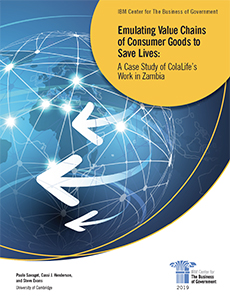
Emulating Value Chains of Consumer Goods to Save Lives: A Case Study of ColaLife’s Work in Zambia

This becomes even more problematic in developing countries with populations residing in remote locales. Getting life-saving medicines to these areas is fraught with many challenges. In a general sense, it is challenging getting health commodities into many of these countries, but even more challenging is getting medicines to those in need who live in remote regions once these medicines are in-country. Given many of these very same remote areas have access to various commercial products such as soft drinks, this reality begs the question: why can’t the supply chain, the value chain, used to get non-medical commodities to remote regions be used to get medicine to where it is needed most? This new report takes up this question, exploring the successful work of ColaLife, a U.K. nonprofit, in Zambia emulating the value chain of a consumer good to provide one life-saving treatment: Oral Rehydration Salts (ORS) and Zinc, for one global killer— childhood diarrhea.
The authors present a roadmap based on an innovative and very successful approach undertaken in Zambia that bypasses deep-rooted bottlenecks for medicine delivery. This work started with the observation that “Coca-Cola seems to get everywhere in developing countries, yet life-saving medicines do not.” Analysis of how fast-moving consumer goods, like Coca-Cola, get into the hands of people living in remote areas of sub-Saharan Africa (SSA) began. This analysis sparked the idea of emulating Coca-Cola’s value chain to improve access to diarrhea treatment—the second biggest infectious killer of under age five children in the region. More than a supply chain, a value chain can be thought of as an ecosystem of relevant players, processes, and resources needed to effectively deliver a product or service to the end user.
This report draws upon this experience in Zambia to provide practical guidance on the key success factors for enabling access to medicines through value chain emulation. The framework offered in this report can be applied in other geographical settings and, potentially, to provide access to other healthcare products. We hope that this report, which tells a story about an effective response that offers insights, reflections, and lessons learned, will be valuable for policymakers and organizations working on access to healthcare.
This report joins another IBM Center report, Responding to Global Health Crises: Lessons from the U.S. Response to the 2014-2016 West Africa Ebola Outbreak, which focus on how best to leverage innovative tools, techniques, and successful processes use to respond to healthcare crises in an international context.



